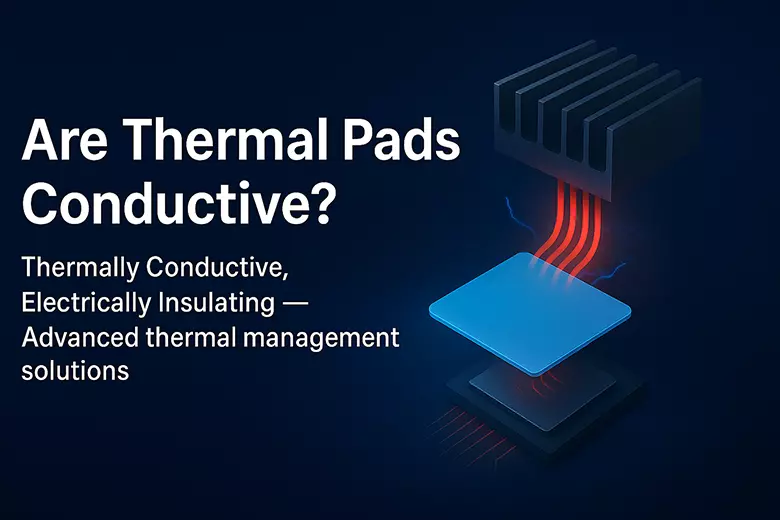In the world of electronics engineering, where extreme performance is pursued, a fundamental question concerning system safety and thermal efficiency is frequently raised: “While conducting heat, do thermal pads also conduct electricity?” The answer to this question determines the approach to thermal management design.
The concise and definitive answer is: High-quality thermal pads are engineered for efficient heat transfer, yet the vast majority are excellent electrical insulators.
This critical property is precisely why modern electronic devices maintain stability and reliability despite soaring power densities. As a trailblazer in thermal management, Sheen Technology invites you to explore the underlying materials science and discover how we empower your innovation.

1. The Cornerstone of Thermal Management: Why Thermal Pads Are Essential
As a critical thermal interface material, thermal pads serve the vital purpose of establishing an efficient “thermal bridge” between heat sources (such as CPUs, GPUs, and power chips) and cooling components (like heat sinks and enclosures).Their value lies in filling microscopic air gaps invisible to the naked eye. Air is a poor thermal conductor, and these gaps create significant thermal resistance that hinders heat dissipation. Thermal pads, with their inherent flexibility and specialized thermal fillers, drastically reduce contact thermal resistance. This significantly boosts the efficiency of the entire cooling system, ensuring electronic components operate stably within their safe temperature window and extending their lifespan.
In cutting-edge fields such as new energy vehicles, 5G communications, high-end computing, and industrial power electronics, Sheen Technology's high-performance thermal pads have become an indispensable element in ensuring system reliability.
2. The Art of Precise Balance: How Can Thermal Conductivity and Insulation Coexist?
The performance secret of thermal pads lies in their meticulously formulated materials.Achieving Insulation and Thermal Conductivity: Most thermal pads use polymers like silicone as a base matrix, filled with non-metallic ceramic materials such as alumina, boron nitride, or zinc oxide. These fillers possess excellent thermal conductivity while remaining electrically insulating. The resulting thermal pads perfectly achieve the design goal of thermal conduction without electrical conductivity, effectively preventing short-circuit risks and protecting sensitive circuits.
The Exception of Thermally Conductive Electrical Materials: Of course, special products like graphene gaskets or certain metal-filled variants exist that also exhibit electrical conductivity. These materials are typically used in specific scenarios requiring electromagnetic shielding or electrical grounding. However, in the vast majority of general electronic designs, engineers prioritize insulating thermal pads to achieve the perfect balance between thermal efficiency and electrical safety.
At Sheen Technology, we understand this principle deeply. Our materials scientists are dedicated to exploring this precise equilibrium, ensuring every material we provide aligns with your needs and meets the demanding requirements of your complex applications.
3. How to Select the Right Thermal Pad?
Selecting an appropriate thermal pad is a systematic process requiring comprehensive consideration of:Thermal Conductivity: Measures the material's inherent heat transfer capability, measured in W/m·K. Higher values aren't always better; compatibility with the overall thermal design is essential.
Dielectric Strength: A critical indicator of the material's resistance to electrical breakdown, directly impacting electrical safety.
Thickness and Compressibility: Affects gap-filling capability and post-assembly mechanical stress.
Operating Temperature Range: Ensures material performance stability under extreme high and low temperatures encountered in equipment environments.
At Sheen Technology, we offer far more than just materials. Through our thermal simulation analysis services and customized thermal management solutions, our engineers collaborate with you to pinpoint optimal choices from complex parameters, achieving peak thermal performance.
4. Application Scenarios: Sheen Materials Empowering Future Technologies
From concept to reality, Sheen Technology's thermal management and insulation materials are at the forefront of every technological innovation:New Energy Vehicles: Ensuring thermal runaway protection for battery packs and sustained high-power operation of electronic control systems.
5G Communications: Providing efficient thermal management for base station AAU and core network equipment chips.
Industrial Power: Safeguarding the reliability of inverters and servo drives in harsh industrial environments.
Premium Consumer Electronics: Enabling “cool” performance delivery in ultra-thin laptops and AR/VR devices.
Our materials deliver consistent reliability even under extreme conditions like vibration and thermal shock, thanks to their exceptional long-term stability.
Thermal pads, seemingly simple materials, are in fact a sophisticated and core component of modern thermal management systems. They perfectly embody the profound meaning of “mastering thermal energy”—not only efficiently conducting heat but also precisely controlling it.
As your partner in thermal management, Sheen Technology's mission is to empower your innovation. Through advanced insulating thermal materials and system-level cooling solutions, we help you overcome thermal design bottlenecks, freeing engineers' ingenuity from the constraints of temperature.

 English
English
 usheenthermal
usheenthermal



